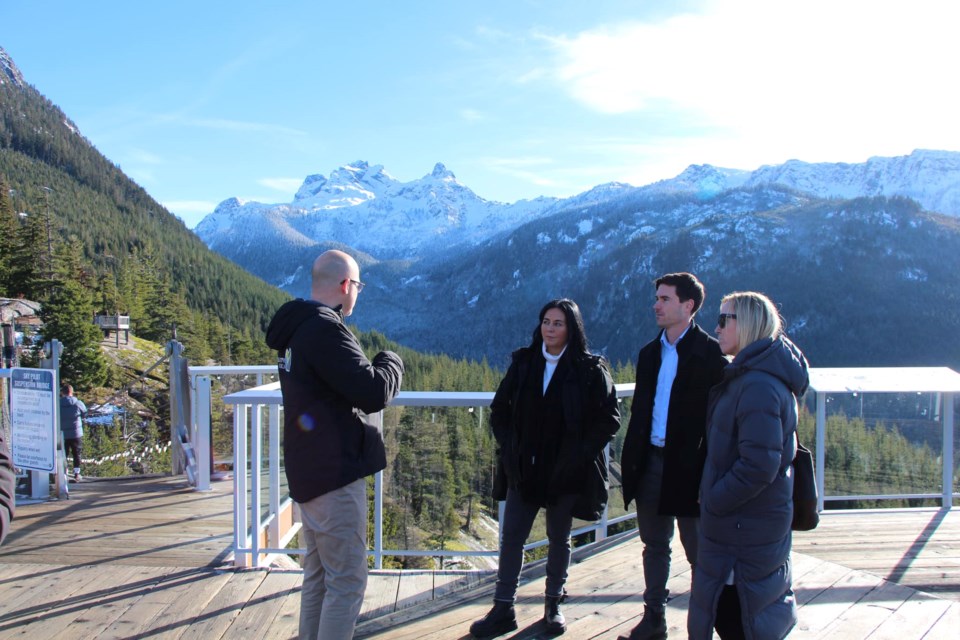The Sea to Sky had a visit from the federal tourism minister last month, with Soraya Martinez Ferrada enjoying a whistle-stop tour on Nov. 16.
Fellow Liberal Party MP and local representative Patrick Weiler said he invited Minister Martinez Ferrada soon after she was appointed tourism minister by Prime Minister Justin Trudeau in July of this year.
“I invited her to come and understand the sector a little better in Whistler … She got a good snapshot of what some of the challenges and opportunities are,” said Weiler.
“It’s really important to be able to meet both with the public and private sector, and Indigenous tourism. The latter is a huge priority for her.”
Martinez Ferrada stopped in on some of the biggest players between Squamish and Whistler, visiting the Sea to Sky Gondola and meeting Tourism Squamish, before stopping by the Squamish Lil’wat Cultural Centre in Whistler with members of the Squamish Nation, while also meeting with the Whistler Chamber of Commerce. Following that, the minister toured Whistler Village with Mayor Jack Crompton and council.
“I met with a diverse range of folks from across the industry, and came away with several common themes,” said Martinez Ferrada in an email to Pique.
“It goes without saying that tourism is crucial to the local economy—there are few regions of Canada where it’s as important as the Sea to Sky—and this feedback shapes our approach to tourism nationwide.”
Asked what she heard from operators and leaders in the area, Martinez Ferrada talked up the federal government’s support for tourism.
“The first thing I heard is that government investments in tourism are paying off—from marketing to direct support for businesses during the pandemic,” she said.
“For the industry to keep growing, government must be there as a partner. In terms of what needs work going forward; housing, labour and transport all stood out. I’m working with colleagues across government to build more housing and bring down its cost, help tourism businesses find the workers they need (including through immigration), and improve transportation links so that visitors can discover more of the region, and the country.”
A key plank in the government’s policy on tourism is the Federal Tourism Growth Strategy, which aims to increase the tourism sector’s contributions towards Canadian GDP by 40 per cent by 2030—or to $61 billion from $43.6 billion in 2019.
“Canada is a tourism superpower, and the Federal Tourism Growth Strategy is our roadmap to help the industry reach its full potential,” said Martinez Ferrada, who listed off the four priorities of the strategy: investing in Canada’s tourism assets, embracing recreation and the great outdoors, partnering to grow Indigenous tourism, and attracting more international events.
One day after her visit to the Sea to Sky, Martinez Ferrada announced a $10-million program to support small Indigenous tourism operations, a sector she said “has the power to create jobs and opportunities, transform Canadian tourism, and advance self-determination and reconciliation. Supporting it, in partnership with Indigenous leaders and groups, is one of our top priorities.”
Weiler described the brief visit by Martinez Ferrada as successful, noting how important it was for her to get insight into what tourism around the country looks like, especially given her position as an MP from Montreal, where tourism is vastly different, and not the main pillar of the local economy.
“She’s not unfamiliar [with tourism] but it was really good to have her on the ground to get a good sense of what some of the current challenges are,” he said.
Weiler noted tourism in the area has mostly rebounded, but there is work to be done.
“There is still a long way to go for international tourism to come back, particularly from the Americans,” he said.
“And we know that’s important, because when you have international visitation, people tend to stay longer, they tend to invest more in the local economy when they’re here. It’s something we need to work on to make sure we keep attracting people to come visit Canada.”




